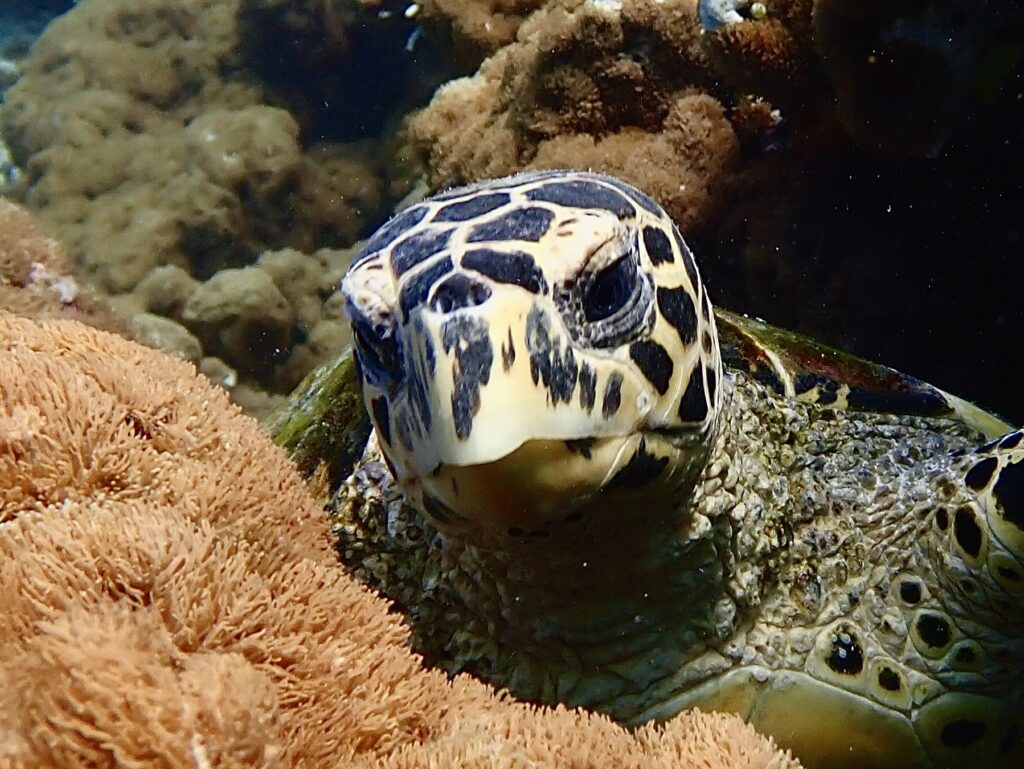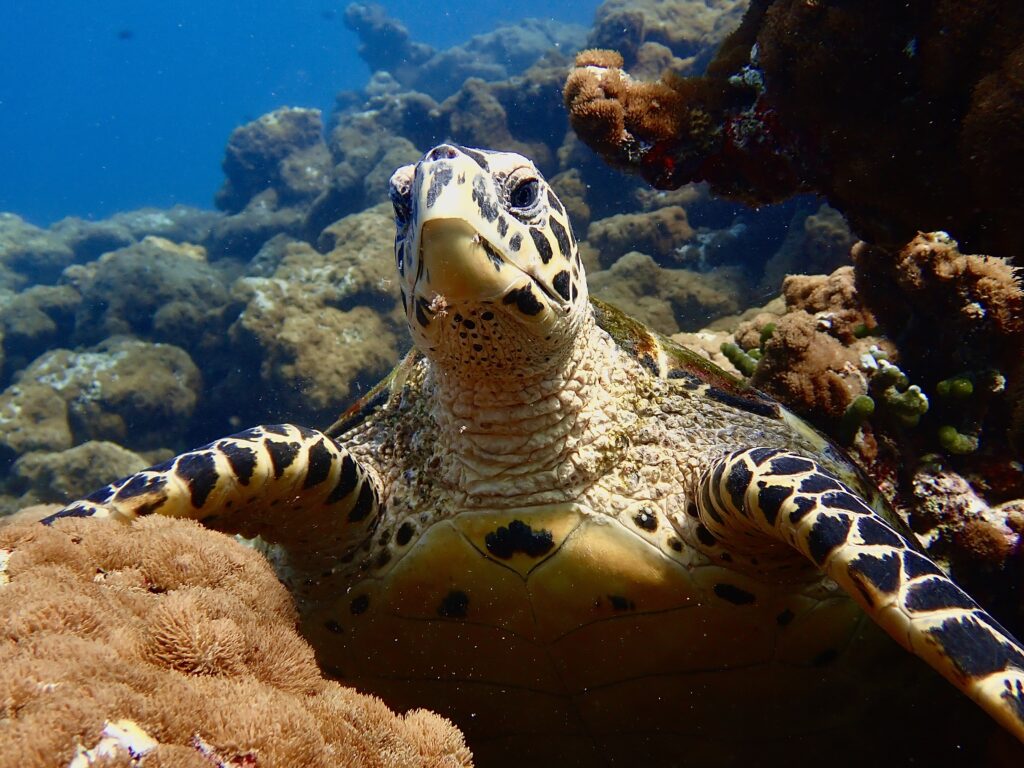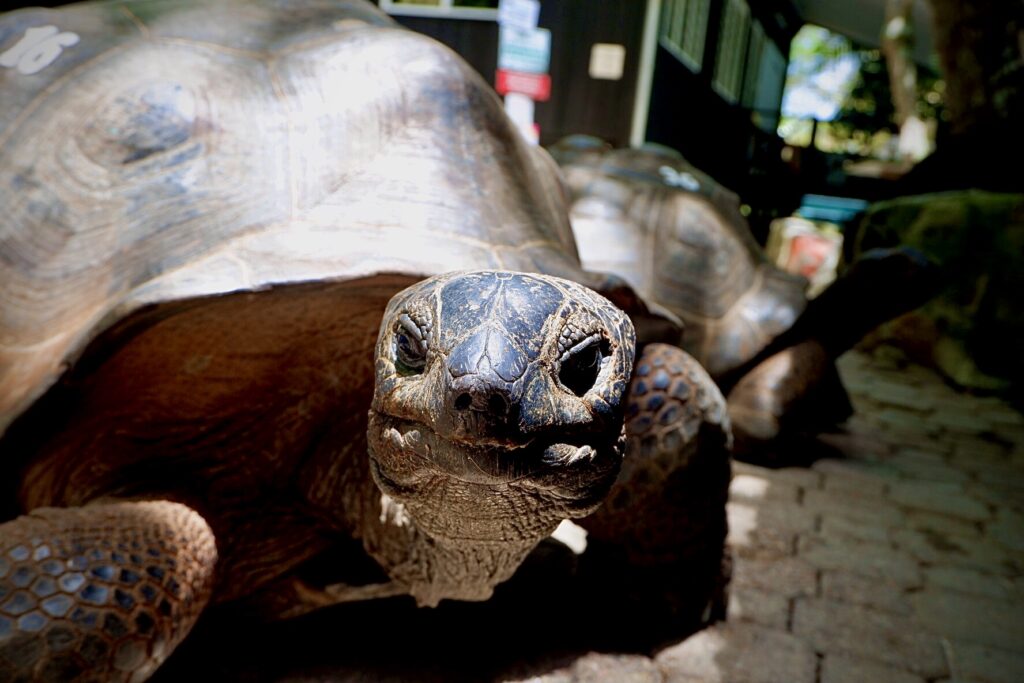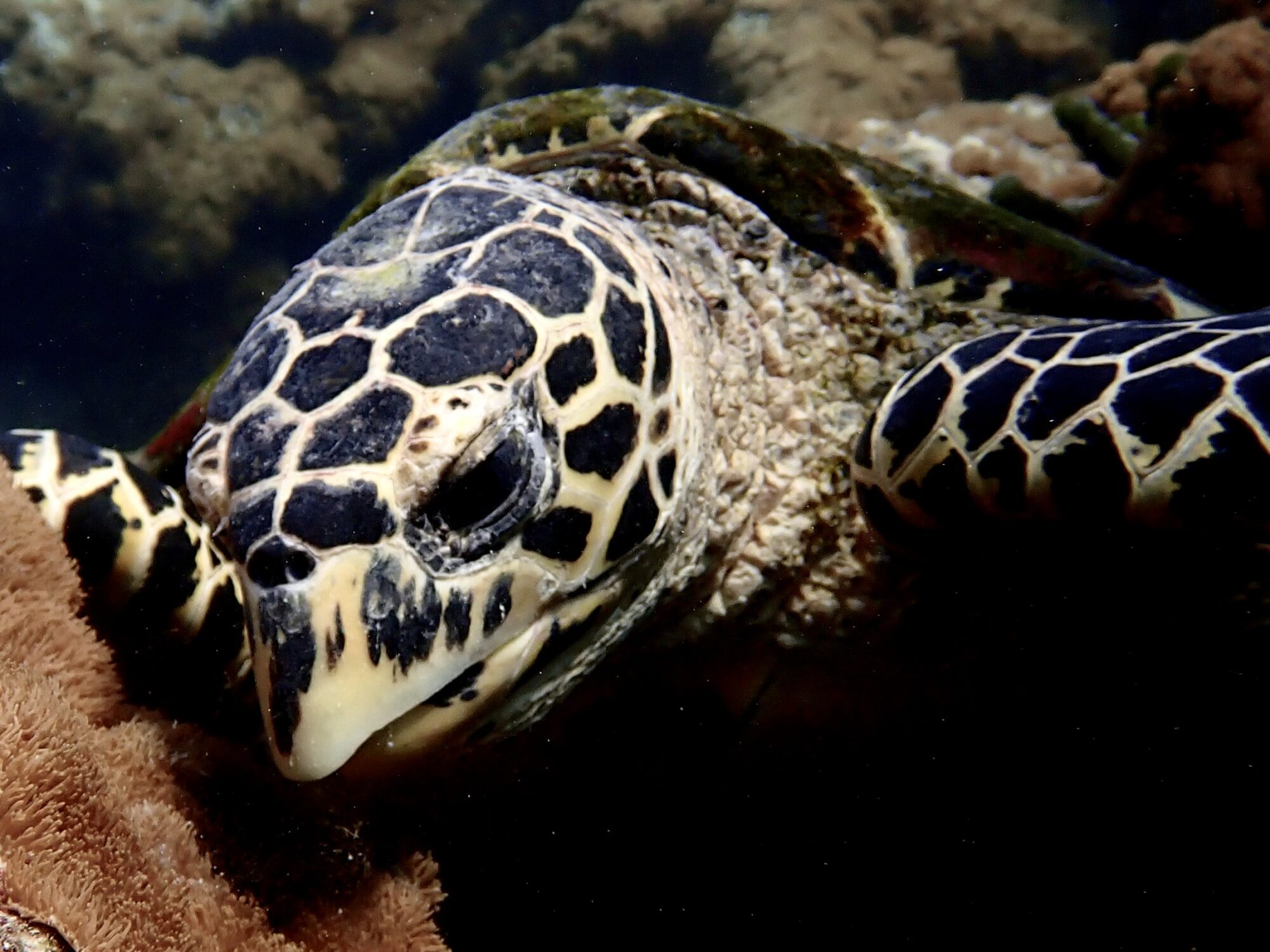Location: West Atlantic (Caribbean), Indian, and Indo-Pacific Oceans
Size: 60cm – 1m (carapace)
Fun Fact: Turtles cry salt
Turtles are among some of the most sought-after creatures to spot while diving or snorkelling. There are seven different species of sea turtles, and in this article, we will focus on the hawksbill.
Appearance
Hawksbills are one of the easiest sea turtles to identify, whether you’re observing them head-on or from above. As their name suggests, they possess a beak resembling that of a hawk. The top part of the beak slightly overhangs the bottom, allowing the turtle to scrape food from rocks and access hard-to-reach crevices more easily.
Their carapace (shell) has jagged edges, it comes down to a point, this is a distinctive feature that makes them easy to spot from above. The colour can vary from a dark green to a brown colour and this would depend on the amount of algae that they have growing on their shell.
Turtles continue to grow throughout their lives, so the larger the turtle, the older it is. Hawksbills can live up to 50–60 years, but they only reach sexual maturity at around 25–30 years of age.

Scutes
There are several global databases that track the migration patterns of turtles. If you’re lucky enough to see a turtle, take a photo or video of its face, as this can help identify the individual. If you happen to encounter a turtle that has not been documented before, you may even have the privilege of naming it!

Turtles have distinctive black and white markings on their faces, called scutes. These patterns are unique to each turtle, much like human fingerprints. The arrangement of these markings differs between species, but each individual will have its own distinctive pattern.
What Do They Eat?
Hawksbills are omnivores, feeding on both plants and animals. They can consume stinging organisms, such as jellyfish and anemones, without harm. Their diet also includes small fish, sponges, and molluscs. Hawksbills play an important role in maintaining healthy ecosystems by eating algae that can otherwise suffocate coral reefs.
Although hawksbills spend their entire lives at sea, you might wonder how they drink. Sea turtles have a special salt gland that allows them to drink seawater and excrete the excess salt through their eyes, which is why it may appear as though they are crying.
The Lost Years
After hatching on the beach, the tiny, black baby turtles make their way to the sea, beginning what is known as the “Lost Years.” During this time, they venture into the open ocean, remaining there for 5–10 years. During this period, they are vulnerable to predators such as birds and larger fish, especially when they approach the coastline. Male hawksbills stay in the ocean for the remainder of their lives, while females only return to land to lay eggs.
Females try to always return to the beach where they were born to lay their eggs. How they navigate back to the same beach after decades is still not fully understood, though it is believed they use the Earth’s magnetic fields to guide them.
Once on the beach, the female faces a difficult task. Having evolved to live in the sea, her body becomes heavy on land, making it challenging to move. As she struggles to drag herself along the beach, she leaves behind tracks. Once she selects a suitable spot, she begins digging a “body pit” using her fins to clear the sand and create a hole in which to lay her eggs. A single clutch typically contains between 100–150 eggs. After laying the eggs, she covers them with sand and returns to the sea, having completed her part.
The eggs take around two months to incubate, and during this time, the temperature of the sand determines the sex of the hatchlings. Cooler temperatures result in males, while warmer temperatures produce females. A simple way to remember: “Cool Dudes, Hot Chicks.”
Unfortunately, with global warming raising sand temperatures, more females are being produced than males, which could threaten the future of the hawksbill population.

Threats To Turtles
Despite being classified as critically endangered, hawksbills are still captured and hunted for their shells, meat, and eggs. In some countries, turtle meat is considered a delicacy, leading to illegal hunting and black-market trade.
Bycatch occurs when a turtle is accidentally caught in fishing nets or on lines intended for other animals. Tragically, this often leads to drowning.
Plastic pollution is another growing threat to turtles. Hawksbills, which often feed on jellyfish, can mistake plastic bags for their natural prey. Consuming too many plastic bags can fill a turtle’s stomach, preventing it from digesting real food.
When turtles surface to breathe, they are at risk of being struck by boats. The turtle’s spine is fused to its carapace, so a collision with any part of a boat, especially the front or propeller, can cause serious, life-threatening injuries.
Efforts to protect hawksbills and other sea turtles are ongoing. Conservation organisations are working to reduce plastic pollution by raising awareness and cleaning up beaches, while sustainable fishing practices are being promoted to prevent bycatch. In some areas, laws have been enacted to protect turtle nesting sites and to curb illegal trade in turtle products
Turtle Vs Tortoise
Both tortoises and turtles belong to the Testudinidae family, but many years ago, they diverged into two distinct species. Tortoises are adapted to life on land, while turtles are well suited for life in the sea.
Turtle
Cannot retract its head
Has fins adapted for swimming
Has a streamlined, flat carapace
Omnivorous (eats both plants and animals)
Tortoise
Can retract its head into its shell
Walks on its tiptoes
Has a round shell
Herbivorous (only eats plants)
Generally has a longer lifespan


